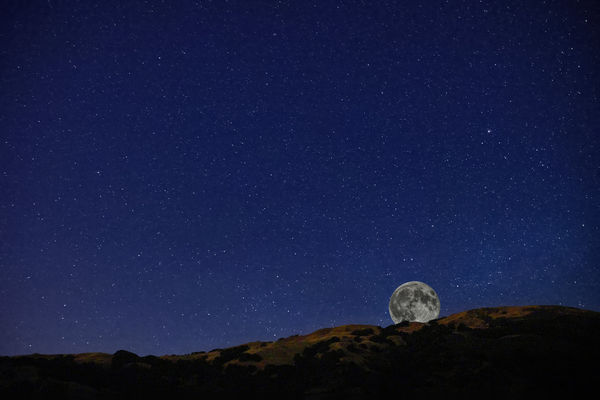Post Processing Out of Sequator
Nov 12, 2020 21:47:42 #
Bittmoore
Loc: SE Wisconsin
I know I'm out on the fringe as I'm not a Photoshop fan, am still feeling my way around PP astrophotos in GIMP and I only found two posts about Sequator here but I'm hoping maybe somebody knows the answer(s).
I've found that most people tend to prefer astroscapes to wide angle starscapes but in trying to use Sequator to freeze the ground using the irregular mask but there always seems to be a bright "glow" around the boundry area and through the ground area.
Any ideas how to minimize it? How best to "fix" it?
I've tried importing the saved mask file into GIMP and more accurately make the mask as I have access to much smaller size brushes. This seems to help with stars between branches but not much difference in the "glow" issue.
I've found that most people tend to prefer astroscapes to wide angle starscapes but in trying to use Sequator to freeze the ground using the irregular mask but there always seems to be a bright "glow" around the boundry area and through the ground area.
Any ideas how to minimize it? How best to "fix" it?
I've tried importing the saved mask file into GIMP and more accurately make the mask as I have access to much smaller size brushes. This seems to help with stars between branches but not much difference in the "glow" issue.
Nov 13, 2020 02:19:29 #
Hi Bittmoore. I tried sequator in the early days with mixed results.
It performed well on some stacks but not on others hence why I returned to DSS as I get constant good results.
A lot of images are wide field star fields, especially my last post.
However I have never tried the 'freeze background' function within sequator.
Perhaps you can find some info on the net or youtube?
regards Marc
It performed well on some stacks but not on others hence why I returned to DSS as I get constant good results.
A lot of images are wide field star fields, especially my last post.
However I have never tried the 'freeze background' function within sequator.
Perhaps you can find some info on the net or youtube?
regards Marc
Nov 13, 2020 11:26:04 #
Bittmoore
Loc: SE Wisconsin
Thanks Marc.
I've been using Sequator for a couple years now off and on. I first tried it out after being disappointed that DSS didn't have a way to process astroscapes without making a mess of the land part of the image. And I understood trying to spoonfeed those types of shots into DSS were never really in the wheelhouse of a program intended for DEEP sky objects. I've had mixed results with Sequator and astroscape images overall. It works pretty well with wide angle starscapes but DSS typically does much better due to the changable parameters.
I may yet need to learn AutoStakkert!
Thanks for replying.
I've been using Sequator for a couple years now off and on. I first tried it out after being disappointed that DSS didn't have a way to process astroscapes without making a mess of the land part of the image. And I understood trying to spoonfeed those types of shots into DSS were never really in the wheelhouse of a program intended for DEEP sky objects. I've had mixed results with Sequator and astroscape images overall. It works pretty well with wide angle starscapes but DSS typically does much better due to the changable parameters.
I may yet need to learn AutoStakkert!
Thanks for replying.
Nov 14, 2020 12:22:53 #
Bittmoore wrote:
I know I'm out on the fringe as I'm not a Photosho... (show quote)
I don't know if there is a way to fix the bright glow in Sequator between the ground and the sky. It is better to learn how to do your own masking.
Here is an example image I created. The moon came from a separate image. And the other image was the sky and foreground. But I also masked it so I had a sky image and a foreground image. I then arranged them is Photoshop so that the foreground was to top layer. The moon the middle layer. And the sky the bottom layer. I then made sure that the foreground slightly overlapped the sky. And then moved the moon around (and resized it as desired) to make the image look natural.
The masking was done by Topaz Mask AI. Don't know if you could do this in GIMP.
Nov 14, 2020 14:29:45 #
Bittmoore
Loc: SE Wisconsin
Thanks JimH123.
Yes, GIMP supports layers. I was just curious whether there might be some better methods of utilizing Sequator's abilities. I well know I need more experience using GIMP for astroscapes.
Haven't had many clear nights with good seeing lately so I've been going back through some of my planning captures (identifying better/best site locations, direction, objects/landmarks for inclusion, ...) to see what I can actually get out of them and all the Sequestor processed astroscape images have a pronounced banding along the land/sky boundary.
As I don't have and have never used PS trying to watch PS-centric how-to videos has not been overly beneficial.
Here's a couple examples:
Yes, GIMP supports layers. I was just curious whether there might be some better methods of utilizing Sequator's abilities. I well know I need more experience using GIMP for astroscapes.
Haven't had many clear nights with good seeing lately so I've been going back through some of my planning captures (identifying better/best site locations, direction, objects/landmarks for inclusion, ...) to see what I can actually get out of them and all the Sequestor processed astroscape images have a pronounced banding along the land/sky boundary.
As I don't have and have never used PS trying to watch PS-centric how-to videos has not been overly beneficial.
Here's a couple examples:
This is from a planning session this past July set up at the south end of my backyard in preparation of some much longer sessions this winter.
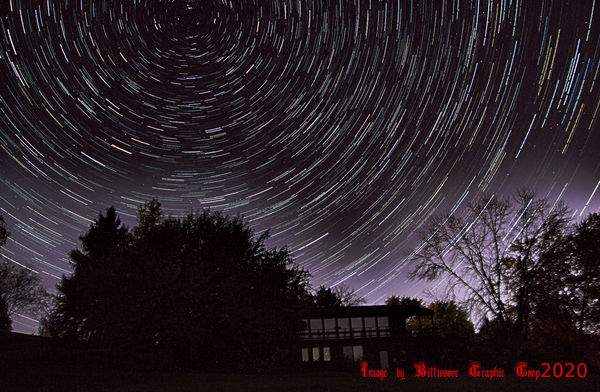
Using layers in GIMP I was able to negate much of the banding except around the top of the center trees in this southernly view from my porch (visible in above picture). Too many mosquitos that night to set up down on the ground.
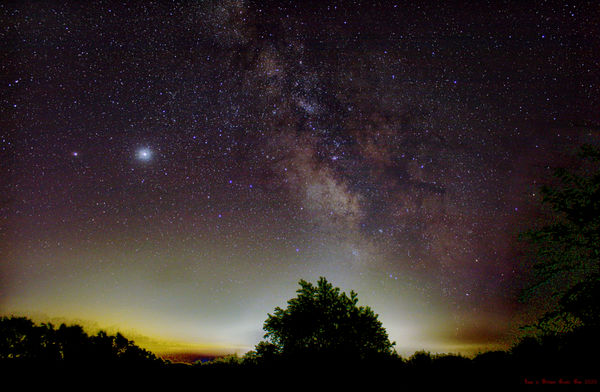
Nov 14, 2020 14:44:11 #
Bittmoore
Loc: SE Wisconsin
Sorry, forgot to include image info. Both taken at home approximately 1hr west of Milwaukee (so still plenty too much light polution)
Canon T6; Canon 18-55mm kit lens; 18mm-f4-15sec-1600; ~75 subs processed in Sequator
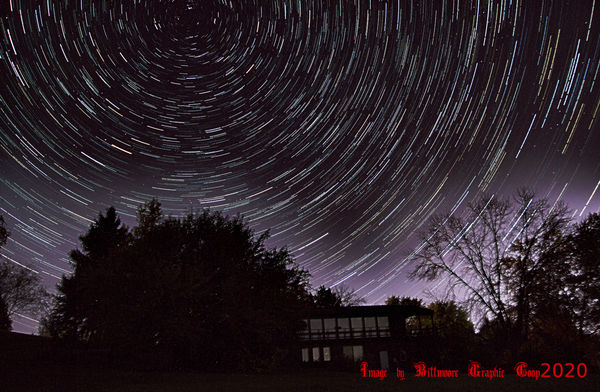
Canon T6; Canon 18-55mm kit lens;18mm-f4-5sec-1600; 6 subs processed in Sequator
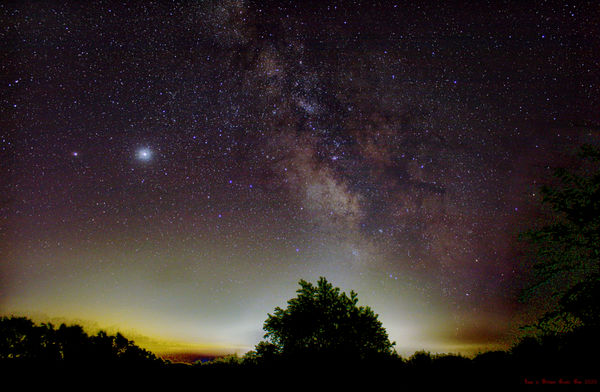
Nov 15, 2020 00:19:27 #
Bittmoore wrote:
Sorry, forgot to include image info. Both taken at home approximately 1hr west of Milwaukee (so still plenty too much light polution)
I don't think Sequator can avoid that banding and I think you will need to do this in layers. I would find a place to shoot the star trails without a foreground obstruction and to then find some foreground you wish to use and shoot it separately. And this image will have to be your top layer, and the sky will have to be removed. And the startrails as the bottom layer and then figure out how you want to position the startrails behind the foreground.
Some will say this is cheating and that you should do it all at the same time. But face it, the requirements for stars and the requirements for the foreground are not the same.
This glow can also be seen in some HDR applications where the masking is not great. I think it makes them look terrible. There are a number of ways to mask an image and lately, I am finding Topaz Mask AI to work well and doesn't take much effort to get a good mask even with tree branches and leaves in the the way. Don't know if it works with GIMP?
Here is a tutorial on using Mask AI, but it is a couple rev's behind the current 1.35. There are many more.
https://www.bing.com/videos/search?q=topaz+mask+ai+tutorial&docid=608028908335139633&mid=A788CA05ACCCB2733DDCA788CA05ACCCB2733DDC&view=detail&FORM=VIRE
Note: you can mask an image and save it to a file to later load as a layer. Or you can bring in your startrails within Mask AI as is shown how to do in this tutorial with clouds.
Nov 15, 2020 04:21:08 #
Bittmoore
Loc: SE Wisconsin
Thanks again JimH123, I will certainly check out that app. Sounds as though it can be used as a stand alone which is good since PS's monthly subscription and cloud-based delivery are not within my tastes.
I understand the "cheating" way of doing it just trying what's easily available to see what can be produced before settling for the "long way around" methods.
I have also tried using DSS's custom rectangle for selecting sky portions to process and layer together.
For now I'll just keep looking up!
I understand the "cheating" way of doing it just trying what's easily available to see what can be produced before settling for the "long way around" methods.
I have also tried using DSS's custom rectangle for selecting sky portions to process and layer together.
For now I'll just keep looking up!
If you want to reply, then register here. Registration is free and your account is created instantly, so you can post right away.


